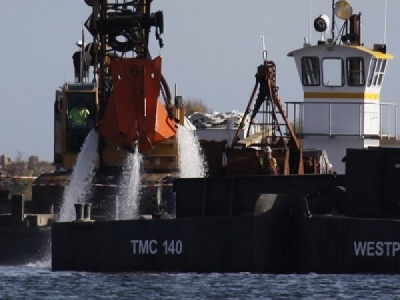
Posted on January 23, 2018
By Jennette Barnes, SouthCoastTODAY
Dredging of PCBs from the floor of New Bedford Harbor south of Interstate 195 should be finished around March of this year, heralding a new day for the harbor, according to David Lederer of the U.S. Environmental Protection Agency.
Workers will still bring waste from farther north to the underground disposal cell beneath that portion of the harbor, but the city will be free to pursue navigational dredging and new uses for waterfront properties.
“This could really bring a new era for the lower harbor,” he said in an interview on Thursday.
Dredging is part of the Port of New Bedford’s plan to extend North Terminal by 800 feet. Port Director Edward Anthes-Washburn said Wednesday that the city needs space for commercial fishing boats and possibly for future cargo or offshore wind operations.
New Bedford Harbor is one of the largest Superfund sites in the nation, contaminated with cancer-causing polychlorinated biphenyls from industrial waste.
North of Interstate 195 this year, the EPA will attack what Lederer said could be the project’s most important work of 2018: cleaning up high PCB levels in the inlet across from and above Aerovox on the Acushnet side. That’s south of the center of town and northwest of Lecuyer Lane.
Some samples from that salt marsh have contained more than 1,000 parts per million of PCBs, Lederer said. The EPA aims to reduce contamination to averages of 25 parts per million along most of the shorelines, 10 ppm in the upper harbor (above Coggeshall Street), and 50 ppm in the lower harbor (Coggeshall Street to the hurricane barrier).
Mark Rasmussen, president of the Buzzards Bay Coalition, has said the lower-harbor goal is 50 times higher than the EPA’s goals for the majority of aquatic Superfund sites nationally.
But Lederer said many readings in the lower harbor have been between 7 and 15.
“In general, we’re getting much lower numbers,” he said.
Lederer said the agency hopes to finish the Acushnet inlet by winter, and then continue south along the shoreline, where work will continue through most or all of 2019.
A shoreline crew will work on the North Street salt marsh in Fairhaven in April, and between the bridges at Coggeshall Street and Interstate 195 over the summer, he said.
Shoreline work is not included in the projected March completion date for dredging south of the interstate.
The EPA plans to open the shore at New Bedford’s Riverside Park to the public this summer. Planting and seeding of grass has been done, but the fence remains to give the grass time to get established, Lederer said.
The agency also intends to install a temporary, underwater cap of sand and clay outside the former Aerovox, a major PCB source, to prevent new contamination from occurring as it works nearby. The state is responsible for handling land-based pollution at the site, he said.
By the end of 2017, the EPA had dredged 665,000 cubic yards of sediment from the harbor. With city and state dredging, the volume reached 1.1 million cubic yards, he said.
About 60 percent of the EPA’s dredged and de-watered material has been loaded on trains and shipped to a Michigan landfill. The rest, with PCBs up to about 100 parts per million, has been buried under the harbor and capped with sand.
Source: SouthCoastTODAY





